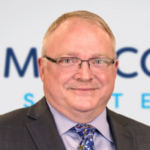 By Dr. Jay Anders, Chief Medical Officer, Medicomp Systems
By Dr. Jay Anders, Chief Medical Officer, Medicomp Systems
Twitter: @MedicompSys
Twitter: @medicompdoc
Host of Tell Me Where IT Hurts – #TellMeWhereITHurts
In the latest Tell Me Where IT Hurts episode, I spent time with a guest I call a “kindred spirit:” Bill Hayes, MD, chief medical officer of CPSI.
I first share how I became involved with “electronic healthcare” in 2004 when my large multi-specialty group practice began searching for an EHR. Before long, I was not only using an EHR but also consulting for an EHR company. Fast forward a few more years and I had switched careers, working full-time as a chief medical officer for a health IT company.
Episode NOW on Demand
Kindred spirit in the health information technology world
Like myself, Dr. Hayes spent the first part of his life “in the trenches treating patients.” He subsequently became a health IT physician executive and is currently the chief medical officer for CPSI, a leading provider of healthcare IT solutions for community hospitals and post-acute care facilities.
Dr. Hayes shares details of his journey, which included many happy years practicing interventional cardiology and treating patients in hospitals, clinics, and ERs. Along the way he realized the tremendous impact of healthcare information computerization on the delivery of care.
When Dr. Hayes’ practice implemented an EHR, it absolutely changed how he provided care on a day-to-day basis. He found the technology frustrating and difficult and was often unable to find the information he needed to treat his patients.
Eventually, Dr. Hayes decided he needed to help EHR vendors do better. He reached out to multiple companies and offered to work with them to fix problems with workflow, clinical input, and information availability. As he began spending time consulting and being a clinical voice for his clinician colleagues, he realized he needed to choose between practicing medicine and providing his clinical input to improve EHRs – and thus made the unexpected shift to working with health IT vendors.
Addressing EHR inefficiencies
Both myself and Dr. Hayes agree that legacy EHRs have suffered from a lack of clinical input. During the design process clinicians have shared what is needed in EHRs, including problem lists, documentation tools, family histories, etc. – but no one has really addressed clinician workflows. As a result, most EHRs are application-driven instead of being applications that support provider workflows. Dr. Hayes believes that what clinicians need are systems that deliver users high-value information that is relative to specific patients and their problems.
To address these challenges on a larger scale, Dr. Hayes is also serving on the HIMSS Electronic Health Records Association Board Council, a trade association that represents about 90% of all EHR companies and is dedicated to building better systems. He is also committed to ensuring universal access to patient-centric electronic records that provide the clinicians with high-value information to help care for a patient at a particular point in time.
CPSI: A healthcare company committed to rural communities
Dr. Hayes shares some of CPSI’s history and its commitment to providing solutions to critical-access hospitals in rural communities that serve as much as 20% of the U.S. population. Dr. Hayes and his CPSI co-workers feel it’s their responsibility to give clinicians in these communities the tools they need to deliver quality care and follow regulatory guidelines – without adding to their workloads.
Medicomp/CPSI Partnership
We close out our chat discussing CPSI’s recent decision to add Medicomp functionality into its EHR platform. Dr. Hayes recalls that the first time he saw Quippe in action, he realized that “these guys have the right idea” because the technology allowed the computer to bring relative, high-value information to users at the point of care. Dr. Hayes expressed excitement for the potential for Quippe to improve patient care, especially as the industry moves to value-based care and clinicians have even greater need to know relative, high-value information to care for patients.
Waving a magic wand
I ask Dr. Hayes one last question: If there was one thing in healthcare IT that you could wave a magic wand and change, and everybody had to do it, what would it be?
To hear Dr. Hayes’ answer, listen to the podcast.
This article was originally published on the Medicomp blog and is republished here with permission.
About the Show
On Tell Me Where IT Hurts, join host Dr. Jay Anders as he sits down with experts from across healthcare and technology to discuss ways to improve EHR usability for end users. Dr. Anders and his guests explore opportunities to enhance clinical systems to make them work better for clinicians, reduce burnout, maximize revenue potential, and drive better patient care outcomes. Join the conversation on Twitter at #TellMeWhereITHurts.
